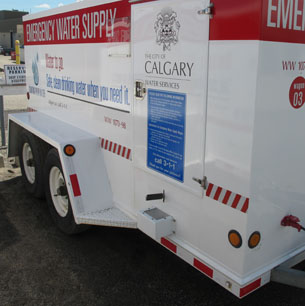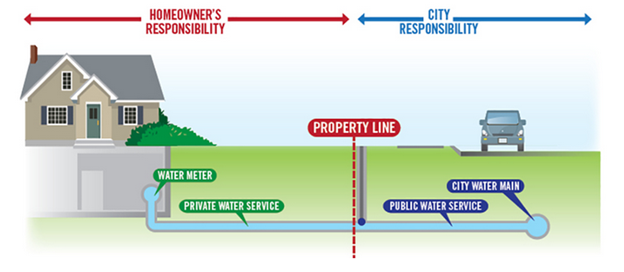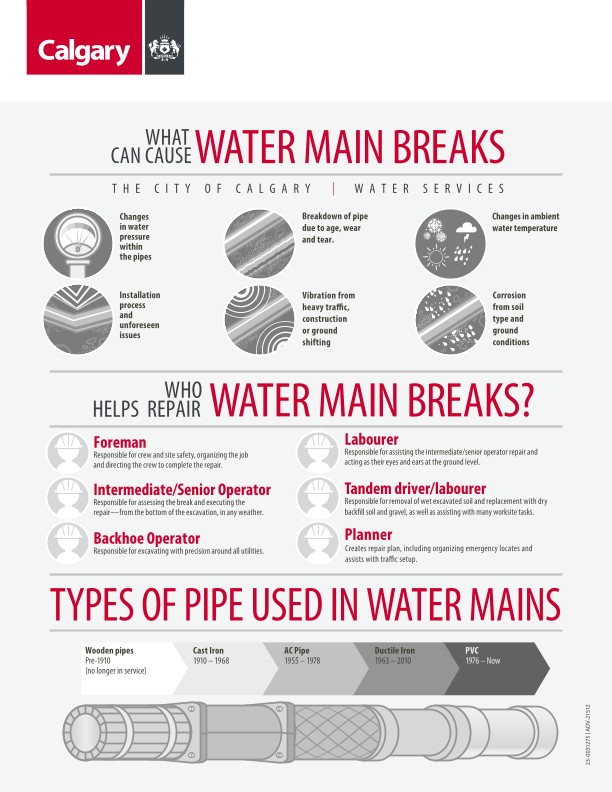Water outages and main breaks
We prioritize breaks based on factors such as the risk of property damage, impact to critical facilities (like hospitals or schools) and the number of customers out of water.
The time it takes to fix a break varies due to several factors, including:
- How quickly the break can be located
- Size and complexity of the break
- Ground conditions for digging such as frozen ground or soil conditions
- Current weather conditions.
Our goal is to have repairs complete and water service restored in under 48 hours, but sometimes this is not possible. A simple repair may take around 24 hours to complete, while complicated breaks may take 72 or more hours to repair.
To ensure you have water for drinking, cooking, and flushing we recommend everyone keep an emergency supply of water on hand. Learn more about preparing your 72-hour emergency preparedness kit.
We know you rely on us to provide reliable access to clean and safe water. When outages happen, we work to notify you and restore service as quickly as possible.
For answers to common questions about water main breaks please see our FAQ below.
Water outage door hanger
During a water outage crews will leave a door hanger on your front door with information for homeowners.
- See the door hanger left at your home for information specific to your water outage, including your recreation pass.
- Translated versions are available below.
Current main breaks and water outages
Note: Our priority is to repair a break and restore water service. Outages are added to this list and information updated as crews are able. Please call 311 to report or if you have concerns about a water outage.
Frequently asked questions
Why wasn’t I notified that my water would be off?
Not all water outages are planned. Water main breaks are unpredictable and can happen for a variety of reasons:
- The age, material, and condition of the pipes
- Condition of the soil
- Temperature of the ground and water
- Pressure changes
How can I get water while the main is being repaired?
Water wagons
- The most common solution is a water wagon - a portable tank that provides you and your neighbours with water for drinking and flushing. It is placed in a central location to provide customers access to water during an outage.
- If you cannot locate the water wagon or there is an issue with it, please contact 311.
Recreation pass
- On each door hanger there is a recreation pass which provides all residents impacted by an outage with access to showers and amenities at a City-run recreation or leisure centre, for up to seven days.
House-to-house temporary line
- When a service line break is located on city property, we may be able to provide water service from one house to another via a temporary line.
- Temporary lines are possible when:
- The property next door is not affected by the outage and the owner agrees to a temporary line.
- It is possible to connect both homes to the temporary line via the outside house bib.
- During colder weather, the property owner on the receiving end is willing to run a tap in their home 24/7 to ensure the line does not freeze.
- The property owner on the receiving end accepts all risk associated with a temporary service.
- Temporary lines are not provided when a service line break is located on private property. In these cases, the property owner is responsible for providing a temporary water supply.
72-hour emergency preparedness kit
- For shorter outages, and to support you while water wagons or temporary supplies are set up, we recommend keeping a small emergency supply of water on hand. You can continue to use the toilet during interruptions by pouring stored water into your toilet bowl to empty its contents.
- Learn more about preparing your 72-hour emergency preparedness kit.
How do water wagons work?
When deployed, the water wagon is placed in a central location. Water wagons are disinfected and water quality is sampled before each delivery.
The water spout is located on the side of the wagon facing the curb, below the list of instructions.
When taking water:
- Place container under spout - avoid touching container on the spout
- Depress lever to begin flow of water
- Release lever to stop water flow
When drawing water from the emergency water wagon, please use the following guidelines to ensure proper storage of your drinking water supply:
- Store your water in thoroughly washed containers that have a good seal. Plastic containers such as soft drink bottles work well.
- Never use a container that has held toxic substances.
- Store your water away from gasoline, kerosene, pesticides or similar substances.
- Ensure storage containers are firmly sealed when you’re not using your water.
If you cannot locate the water wagon or there is an issue with it, please complete the online service request below or contact 311.

Is it possible to sign-up for notifications about water outages affecting my property?
Yes – The City has recently launched email and text notifications. You can sign up for these via your myID Account. These notifications are like those for street sweeping and snow route bans.
Things to note:
- Currently, notifications are only possible on a community basis. This means if you live in Altadore, you will receive notifications for all water outages in Altadore. The address of the outage will be included in your text and/or email.
- Over 2026 improvements are being made to our system which will help pinpoint outages specifically affecting your property. We appreciate your patience while these upgrades are made.
- You will continue to receive updates until water service is restored. This means as the repair moves from investigation to active repairs to water being restored, you will receive an email and/or text.
- Texts and emails are automatic responses. Please do not reply to these messages as they are not monitored. For more information, please refer to this webpage or call 311.
What should I do once my water is turned back on?
We test for quality before water is restored. To ensure the issue is resolved:
- Run your bathtub tap on cold for 10 minutes until water clears. Then run other cold water taps for five minutes or until clear.
- Wash tap aerators or screens in hot, soapy water, and disinfect them for 10 minutes in a solution of one part bleach to nine parts water.
- Disinfect water filters to manufacturer's recommendations.
If water does not clear after running the taps, please contact 311.
When will the road be repaired?
Once the water main repair is complete and Water Services has completed filling in the excavation, crews will work to pave the area with asphalt.
During the winter months, to ensure the road remains drivable, the excavation site is filled with available seasonal mix.
Crews will return in the spring to pave this roadway when permanent repairs can be completed - exact dates cannot be provided at this time. If lawn repairs are also required, those will be done between May and October.
Depending on the location, barricades may be in place to ensure the safety of citizens. Please do not move or remove them.
If the excavation site sinks or you have any other concerns, please call 311 and reference “sunken excavation.”
When will my driveway and/or sidewalk be repaired?
Crews will return to the site over the next several weeks to apply a temporary asphalt patch.
A final concrete repair will be added to The City’s road repair schedule - exact dates of repair cannot be provided at this time. To ensure the base layer is properly compacted, we schedule the sidewalk for concrete replacement following a full freeze-thaw cycle, typically two years after repair.
If lawn repairs are also required, they are typically performed between May and October.
Depending on the location, barricades may be in place to ensure the safety of citizens. Please do not move or remove them.
If the excavation site sinks or you have any other concerns, please call 311 and reference “sunken excavation.”
Does a main break mean there is a problem with our water delivery system?
No, water main breaks happen. We maintain nearly 15,000 kilometres of underground water infrastructure as part of our drinking water, wastewater and stormwater systems and have one of the lowest number of average breaks per 100 kilometres when compared to other major Canadian cities.
How does temperature impact water mains?
The longer the temperature stays below freezing, the deeper the frost goes, putting pressure on water main and service pipes. Winter frost depths in Calgary typically range from two to three metres. Frozen ground increases the amount of time required to access the water pipes, resulting in a longer time frame to restore water. Pipes are buried around three to four metres deep.
How is a water main repaired?
- A crew is dispatched to determine the location, impact and severity of the break
- Crews reduce and shutoff water flow by closing nearby water valves
- Crews identify alternative sources for temporary customer water
- Crews excavate and repair the watermain
- Service is restored after the pipe is flushed and water quality is tested
- The road, lane, sidewalk or lawn is repaired. This may take time depending on the season, weather, difficulty of the location and size of the break. If there are damages from the water main repair, we will arrange for rehabilitation or repair. Learn more at Water Service Construction Property Rehab.
Who is responsible for repairs if a break is on private property?
If after investigating a water outage we determine that the break is on private property it is the property owner’s responsibility to make repairs.
The City is responsible for the water service line that extends from the water main up to the homeowner's property line. All pipes, solder and fittings on private property are the responsibility of the property owner. The figure below demonstrates the delineation between the public and private side.

In these cases, tenants should contact their landlord for updates on repairs including timelines and alternative water sources. If you are having an issue with your landlord, please contact the Consumer Contact Centre.
I can see equipment and city vehicles outside my residence, but there doesn’t appear to be repair work underway. What’s going on?
We can assure you that work is underway.
- Crews may be working with a leak locator to determine the location of underground break(s).
- Depending on the size of the break there may be multiple repair locations involved. Crews are likely working on another street nearby or in a back alley.
- The equipment and vehicles you see are on stand-by and waiting to be called into action. This ensures our crews aren’t waiting for repair materials, dump trucks or backhoes to arrive, which can reduce repair times.
What happens if my property has been damaged?
Please visit damage claims and witness statements for more information.
Related links
-
Learn how to protect your home from frozen pipes, water meters and service lines.
-
How to report if storm drains are clogged with ice or snow, or if water isn't draining following heavy storms.


